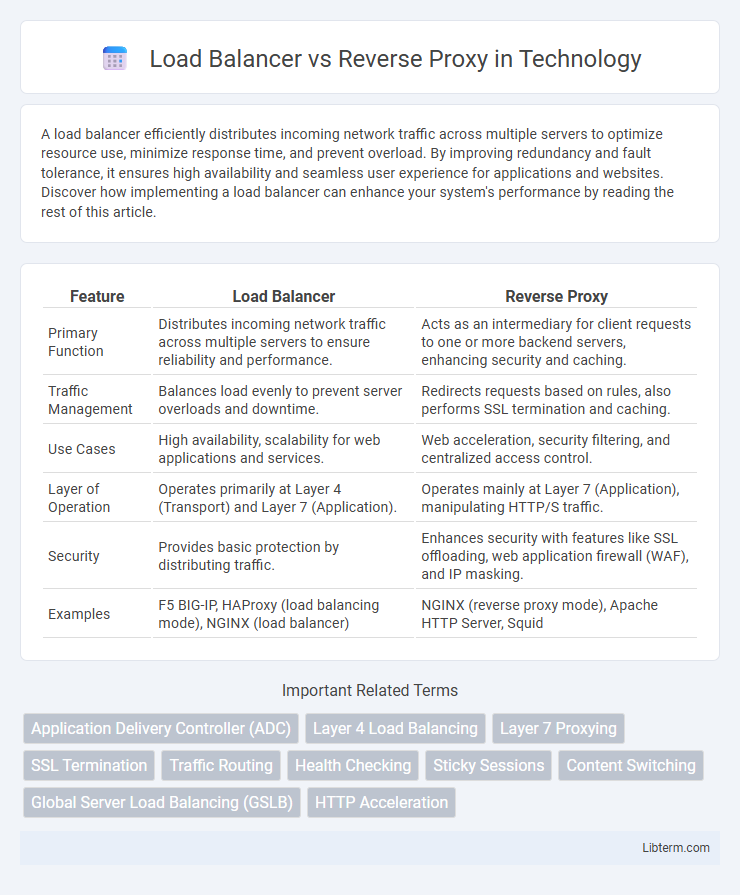A load balancer efficiently distributes incoming network traffic across multiple servers to optimize resource use, minimize response time, and prevent overload. By improving redundancy and fault tolerance, it ensures high availability and seamless user experience for applications and websites. Discover how implementing a load balancer can enhance your system's performance by reading the rest of this article.
Table of Comparison
| Feature | Load Balancer | Reverse Proxy |
|---|---|---|
| Primary Function | Distributes incoming network traffic across multiple servers to ensure reliability and performance. | Acts as an intermediary for client requests to one or more backend servers, enhancing security and caching. |
| Traffic Management | Balances load evenly to prevent server overloads and downtime. | Redirects requests based on rules, also performs SSL termination and caching. |
| Use Cases | High availability, scalability for web applications and services. | Web acceleration, security filtering, and centralized access control. |
| Layer of Operation | Operates primarily at Layer 4 (Transport) and Layer 7 (Application). | Operates mainly at Layer 7 (Application), manipulating HTTP/S traffic. |
| Security | Provides basic protection by distributing traffic. | Enhances security with features like SSL offloading, web application firewall (WAF), and IP masking. |
| Examples | F5 BIG-IP, HAProxy (load balancing mode), NGINX (load balancer) | NGINX (reverse proxy mode), Apache HTTP Server, Squid |
Introduction to Load Balancers and Reverse Proxies
Load balancers distribute incoming network traffic across multiple servers to ensure reliability and optimal resource utilization, enhancing system performance and fault tolerance. Reverse proxies act as intermediaries that forward client requests to backend servers, providing benefits like security, caching, and SSL termination. Both technologies improve scalability and availability but serve distinct roles within network architecture.
What is a Load Balancer?
A load balancer distributes incoming network traffic across multiple servers to ensure no single server becomes overwhelmed, enhancing application availability and reliability. It operates at various layers of the OSI model, commonly using algorithms like round-robin, least connections, or IP hash to efficiently balance requests. Load balancers improve scalability, fault tolerance, and optimize resource utilization in complex web architectures.
What is a Reverse Proxy?
A reverse proxy is a server that sits between client devices and backend servers, forwarding client requests to appropriate servers while concealing the identity and structure of the backend infrastructure. It enhances security by masking IP addresses, enables load distribution, and can perform SSL termination, caching, and compression. Unlike traditional load balancers that primarily distribute traffic, reverse proxies provide advanced traffic management and security features to optimize web application performance.
Key Differences Between Load Balancers and Reverse Proxies
Load balancers distribute incoming network traffic across multiple servers to ensure high availability and reliability, optimizing resource use and minimizing response time. Reverse proxies act as intermediaries between clients and backend servers, providing functions like caching, SSL termination, and security filtering. While load balancers primarily focus on traffic distribution for scalability, reverse proxies emphasize request handling and security enhancements within web infrastructure.
How Load Balancers Work
Load balancers distribute incoming network traffic across multiple servers to optimize resource use, maximize throughput, and reduce latency. They monitor server health and automatically redirect traffic to healthy servers, ensuring high availability and fault tolerance. By managing server loads efficiently, load balancers enhance application performance and enable seamless scalability.
How Reverse Proxies Operate
Reverse proxies operate by intercepting client requests and forwarding them to one or multiple backend servers, effectively acting as an intermediary that enhances security, load distribution, and caching. They mask the identity of backend servers, optimize performance through SSL termination and compression, and can implement access control policies. This operation contrasts with load balancers, which primarily focus on distributing network traffic across servers to ensure availability and reliability.
Use Cases for Load Balancers
Load balancers efficiently distribute incoming network traffic across multiple servers to ensure high availability and reliability in web applications, making them ideal for handling large-scale, high-traffic environments such as e-commerce platforms and cloud services. They optimize resource utilization and prevent server overload by monitoring server health and redirecting traffic to operational nodes, essential for maintaining consistent performance during peak usage. Load balancers also play a critical role in fault tolerance and scalability by enabling seamless addition or removal of backend servers without service disruption.
Use Cases for Reverse Proxies
Reverse proxies are primarily used to enhance web application security by masking backend server details, providing SSL termination, and enabling DDoS mitigation. They optimize content delivery through caching, compressing responses, and routing client requests to appropriate servers based on load or geographic location. In microservices architectures, reverse proxies facilitate service discovery and API gateway functionalities, streamlining client interactions with complex distributed systems.
Choosing Between Load Balancer and Reverse Proxy
When choosing between a load balancer and a reverse proxy, consider that load balancers distribute incoming network traffic across multiple servers to enhance availability and reliability, optimizing resource use and preventing overload. Reverse proxies primarily act as intermediaries protecting backend servers, handling tasks like caching, SSL termination, and security enforcement, improving performance and securing server identity. Decision factors include the need for traffic distribution and fault tolerance (favoring load balancers) versus enhanced security, caching, and SSL management (favoring reverse proxies).
Conclusion: Which Solution is Best for You?
Choosing between a load balancer and a reverse proxy depends on your application's requirements for traffic distribution, security, and scalability. Load balancers excel in efficiently distributing incoming network traffic across multiple servers to ensure high availability and performance, while reverse proxies primarily provide enhanced security, SSL termination, and caching capabilities. For large-scale applications demanding robust traffic management and fault tolerance, load balancers are ideal, whereas reverse proxies suit scenarios needing secure access control and content optimization.
Load Balancer Infographic

 libterm.com
libterm.com